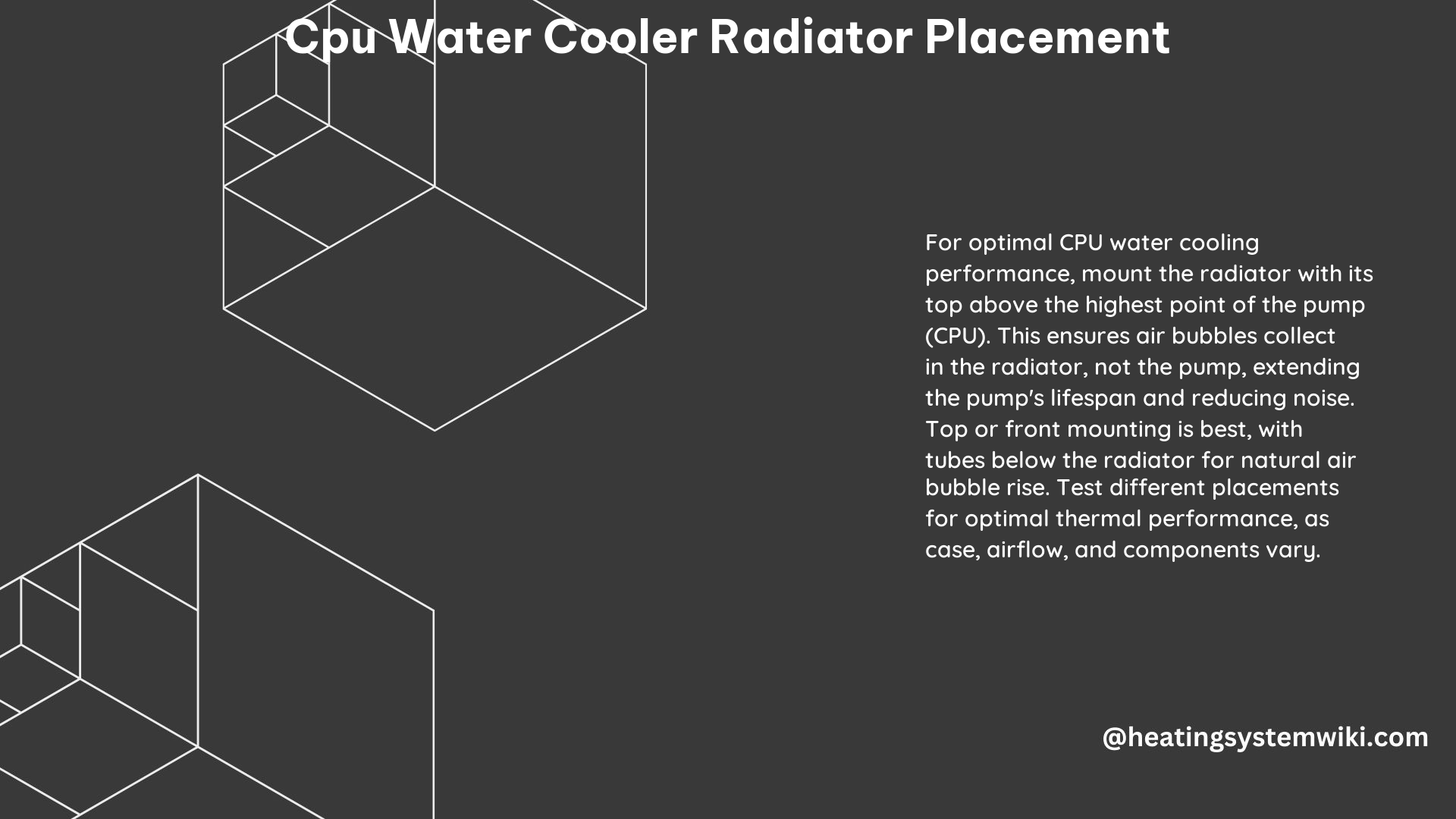The placement of a CPU water cooler radiator is a crucial factor in the overall performance of the cooling system. Proper radiator positioning can significantly impact the efficiency of heat dissipation, air bubble management, and the overall lifespan of the cooling components. This comprehensive guide will delve into the intricacies of CPU water cooler radiator placement, providing you with the technical knowledge and specific details needed to ensure optimal cooling performance for your system.
The Ideal Radiator Placement: Perpendicular to the Waterblock
The best way to install an AIO (All-in-One) liquid cooler is to have the radiator positioned perpendicularly above the waterblock. This orientation allows air bubbles to accumulate evenly throughout the radiator fins, and the hoses positioned above the pump in the waterblock aid in releasing air bubbles from the pump.
Specifically, the ideal radiator-to-waterblock distance should be between 2 to 4 inches (5 to 10 cm) to ensure optimal heat transfer and air bubble management. This distance allows for efficient heat dissipation while providing enough space for the air bubbles to rise and be expelled from the system.
Vertical Radiator Mounting: The Next Best Option

If top-mounting the radiator is not possible, the next best option is to have the radiator vertically oriented with the hose side on the bottom. This configuration ensures that the position of the waterblock/pump is below the edge tank of the radiator. This allows air bubbles to collect in the edge tank, preventing them from affecting the pump or the hoses.
When vertically mounting the radiator, it’s crucial to maintain a minimum clearance of 2 inches (5 cm) between the bottom of the radiator and the top of the waterblock/pump. This spacing allows for proper air bubble management and ensures the pump operates efficiently.
Vertical Radiator with Top-Mounted Hoses
In instances where the radiator must be mounted vertically with the hoses on top, it’s important to position the waterblock/pump below the radiator’s edge tank from the top. This compromise ensures the pump will work optimally with minimal air bubbles, as the air bubbles will collect in the edge tank rather than being drawn into the pump.
To achieve this, the distance between the top of the waterblock/pump and the bottom of the radiator’s edge tank should be at least 2 inches (5 cm). This spacing allows for proper air bubble separation and prevents air from being drawn into the pump.
Avoiding the Worst-Case Scenario: Horizontal Radiator Mounting
The worst way to install an AIO liquid cooler is to have the waterblock/pump positioned above a horizontally mounted radiator. This configuration results in the pump producing more noise and running inefficiently as it constantly pumps air bubbles. Upon startup, liquid circulation could even stall as a large air pocket collects in the pump area while the system was off.
To avoid this scenario, it’s crucial to never mount the radiator horizontally with the waterblock/pump positioned above it. This arrangement can severely compromise the cooling system’s performance and lead to premature component failure.
Radiator Mounting Locations: Optimizing Airflow
In terms of case mounting locations, the radiator can be installed on the top, front, or bottom of a PC case. The location will affect the thermal performance of the cooling system.
For optimal airflow, it’s recommended to have the radiator as an intake at the front of the case, and exhaust at the top or rear of the case. This configuration ensures that the radiator receives a steady supply of cool air, which is then expelled from the case, effectively dissipating the heat generated by the CPU.
Cooling Tube Flow Direction: Prioritizing Pump Longevity
When it comes to the flow direction of the cooling tubes, it’s generally recommended to have the tubes coming out of the radiator and going into the pump (what is on the CPU in an AIO). This arrangement helps to prevent air bubbles from being drawn into the pump, which can significantly reduce its lifespan.
If the tubes are positioned below the pump, there’s a risk of damaging the pump or significantly reducing its operational lifespan. The pump should always be positioned at the lowest point in the cooling loop to ensure proper air bubble management and efficient liquid circulation.
Conclusion
In summary, the best way to install an AIO liquid cooler is to have the radiator perpendicularly above the waterblock, with the hoses above the pump in the waterblock. If top mounting isn’t possible, the next best option is to have the radiator vertically oriented with the hose side on the bottom. It’s crucial to avoid having the waterblock/pump positioned above a horizontally mounted radiator, as this can result in reduced performance and increased noise.
The case mounting location and flow direction of the cooling tubes also play a crucial role in the overall performance and longevity of the cooling system. By following the technical guidelines and specific details outlined in this comprehensive guide, you can ensure optimal CPU water cooler radiator placement and achieve the best possible cooling performance for your system.
References:
– Optimizing AIO Liquid Cooler Placement
– Silverstone’s Recommendations for AIO Mounting
– MSI’s Guide on Proper Liquid Cooler Placement
– CCL Online’s Article on AIO Water Cooling Best Setup
